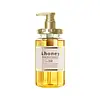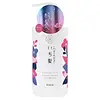What's inside
What's inside
 Key Ingredients
Key Ingredients

No key ingredients
 Benefits
Benefits

 Concerns
Concerns

 Ingredients Side-by-side
Ingredients Side-by-side

Water
Skin ConditioningLauramidopropyl Betaine
CleansingSodium C14-16 Olefin Sulfonate
CleansingSodium Lauroyl Taurate
CleansingGlycerin
HumectantCocamide DEA
EmulsifyingTea-Lauroyl Methylaminopropionate
CleansingTea-Cocoyl Glutamate
CleansingParfum
MaskingPolyquaternium-10
Sodium Benzoate
MaskingMyristyl Betaine
CleansingPhenoxyethanol
PreservativeCitric Acid
BufferingDisodium EDTA
Polyquaternium-47
Skin ConditioningMenthol
MaskingCaramel
Cosmetic ColorantHoney
HumectantArginine
MaskingPanthenol
Skin ConditioningArgania Spinosa Kernel Oil
EmollientShea Butter Glycereth-8 Esters
CleansingButylene Glycol
HumectantGluconobacter/Honey Ferment Filtrate
Skin ConditioningPPG-7
Skin ConditioningAcacia Senegal Gum
MaskingHoney Extract
HumectantCoco-Glucoside
CleansingKeratin
Skin ConditioningHydrolyzed Honey Protein
Skin ConditioningRoyal Jelly Extract
Skin ConditioningPaeonia Officinalis Flower Extract
TonicPropolis Extract
Skin ConditioningHydrolyzed Silk
HumectantHydroxypropyltrimonium Hyaluronate
Methylchloroisothiazolinone
PreservativeMethylisothiazolinone
PreservativePotassium Sorbate
PreservativeMagnesium Nitrate
Magnesium Chloride
Water, Lauramidopropyl Betaine, Sodium C14-16 Olefin Sulfonate, Sodium Lauroyl Taurate, Glycerin, Cocamide DEA, Tea-Lauroyl Methylaminopropionate, Tea-Cocoyl Glutamate, Parfum, Polyquaternium-10, Sodium Benzoate, Myristyl Betaine, Phenoxyethanol, Citric Acid, Disodium EDTA, Polyquaternium-47, Menthol, Caramel, Honey, Arginine, Panthenol, Argania Spinosa Kernel Oil, Shea Butter Glycereth-8 Esters, Butylene Glycol, Gluconobacter/Honey Ferment Filtrate, PPG-7, Acacia Senegal Gum, Honey Extract, Coco-Glucoside, Keratin, Hydrolyzed Honey Protein, Royal Jelly Extract, Paeonia Officinalis Flower Extract, Propolis Extract, Hydrolyzed Silk, Hydroxypropyltrimonium Hyaluronate, Methylchloroisothiazolinone, Methylisothiazolinone, Potassium Sorbate, Magnesium Nitrate, Magnesium Chloride
Water
Skin ConditioningLauroyl Sarcosine
CleansingPalm Kernelamidopropyl Betaine
CleansingCocamide Methyl Mea
Lauroyl Methyl Beta-Alanine
Skin ConditioningCocamide Mea
EmulsifyingGlycol Distearate
EmollientAngelica Keiskei Leaf/Stem Extract
Skin ConditioningOryza Sativa Bran Oil
EmollientOryza Sativa Extract
AbsorbentDianthus Longicalyx Seed Extract
Emulsion StabilisingRubus Idaeus Extract
Skin ProtectingZea Mays Germ Oil
EmollientRubus Fruticosus Fruit Extract
AstringentCamellia Sinensis Seed Extract
HumectantOryza Sativa Bran Extract
Skin ConditioningCitric Acid
BufferingPEG-7 Glyceryl Cocoate
EmulsifyingSodium Chloride
MaskingGuar Hydroxypropyltrimonium Chloride
Skin ConditioningPolyquaternium-7
Polyquaternium-10
Butylene Glycol
HumectantAlcohol Denat.
AntimicrobialPropanediol
SolventDisodium EDTA
Sodium Benzoate
MaskingParfum
MaskingCaramel
Cosmetic ColorantWater, Lauroyl Sarcosine, Palm Kernelamidopropyl Betaine, Cocamide Methyl Mea, Lauroyl Methyl Beta-Alanine, Cocamide Mea, Glycol Distearate, Angelica Keiskei Leaf/Stem Extract, Oryza Sativa Bran Oil, Oryza Sativa Extract, Dianthus Longicalyx Seed Extract, Rubus Idaeus Extract, Zea Mays Germ Oil, Rubus Fruticosus Fruit Extract, Camellia Sinensis Seed Extract, Oryza Sativa Bran Extract, Citric Acid, PEG-7 Glyceryl Cocoate, Sodium Chloride, Guar Hydroxypropyltrimonium Chloride, Polyquaternium-7, Polyquaternium-10, Butylene Glycol, Alcohol Denat., Propanediol, Disodium EDTA, Sodium Benzoate, Parfum, Caramel
 Reviews
Reviews

Ingredients Explained
These ingredients are found in both products.
Ingredients higher up in an ingredient list are typically present in a larger amount.
Butylene Glycol (or BG) is used within cosmetic products for a few different reasons:
Overall, Butylene Glycol is a safe and well-rounded ingredient that works well with other ingredients.
Though this ingredient works well with most skin types, some people with sensitive skin may experience a reaction such as allergic rashes, closed comedones, or itchiness.
Learn more about Butylene GlycolWe don't have a description for Caramel yet.
Citric Acid is an alpha hydroxy acid (AHA) naturally found in citrus fruits like oranges, lemons, and limes.
Like other AHAs, citric acid can exfoliate skin by breaking down the bonds that hold dead skin cells together. This helps reveal smoother and brighter skin underneath.
However, this exfoliating effect only happens at high concentrations (20%) which can be hard to find in cosmetic products.
Due to this, citric acid is usually included in small amounts as a pH adjuster. This helps keep products slightly more acidic and compatible with skin's natural pH.
In skincare formulas, citric acid can:
While it can provide some skin benefits, research shows lactic acid and glycolic acid are generally more effective and less irritating exfoliants.
Most citric acid used in skincare today is made by fermenting sugars (usually from molasses). This synthetic version is identical to the natural citrus form but easier to stabilize and use in formulations.
Read more about some other popular AHA's here:
Learn more about Citric AcidDisodium EDTA plays a role in making products more stable by aiding other preservatives.
It is a chelating agent, meaning it neutralizes metal ions that may be found in a product.
Disodium EDTA is a salt of edetic acid and is found to be safe in cosmetic ingredients.
Learn more about Disodium EDTAParfum is a catch-all term for an ingredient or more that is used to give a scent to products.
Also called "fragrance", this ingredient can be a blend of hundreds of chemicals or plant oils. This means every product with "fragrance" or "parfum" in the ingredients list is a different mixture.
For instance, Habanolide is a proprietary trade name for a specific aroma chemical. When used as a fragrance ingredient in cosmetics, most aroma chemicals fall under the broad labeling category of “FRAGRANCE” or “PARFUM” according to EU and US regulations.
The term 'parfum' or 'fragrance' is not regulated in many countries. In many cases, it is up to the brand to define this term.
For instance, many brands choose to label themselves as "fragrance-free" because they are not using synthetic fragrances. However, their products may still contain ingredients such as essential oils that are considered a fragrance by INCI standards.
One example is Calendula flower extract. Calendula is an essential oil that still imparts a scent or 'fragrance'.
Depending on the blend, the ingredients in the mixture can cause allergies and sensitivities on the skin. Some ingredients that are known EU allergens include linalool and citronellol.
Parfum can also be used to mask or cover an unpleasant scent.
The bottom line is: not all fragrances/parfum/ingredients are created equally. If you are worried about fragrances, we recommend taking a closer look at an ingredient. And of course, we always recommend speaking with a professional.
Learn more about ParfumPolyquaternium-10 is an ammonium salt of hydroxyethylcellulose. It is a white and granular powder used as a film-former and anti-static agent.
This ingredient is commonly found in hair conditioning products. According to a manufacturer, its positive charge makes it great for absorbing hair proteins. The manufacturer also states this ingredient helps with curl retention.
For haircare friends: this ingredient is not a silicone.
Learn more about Polyquaternium-10Sodium Benzoate is a preservative. It's used in both cosmetic and food products to inhibit the growth of mold and bacteria. It is typically produced synthetically.
Both the US FDA and EU Health Committee have approved the use of sodium benzoate. In the US, levels of 0.1% (of the total product) are allowed.
Sodium benzoate works as a preservative by inhibiting the growth of bacteria inside of cells. It prevents the cell from fermenting a type of sugar using an enzyme called phosphofructokinase.
It is the salt of benzoic acid. Foods containing sodium benzoate include soda, salad dressings, condiments, fruit juices, wines, and snack foods.
Studies for using ascorbic acid and sodium benzoate in cosmetics are lacking, especially in skincare routines with multiple steps.
We always recommend speaking with a professional, such as a dermatologist, if you have any concerns.
Learn more about Sodium BenzoateWater. It's the most common cosmetic ingredient of all. You'll usually see it at the top of ingredient lists, meaning that it makes up the largest part of the product.
So why is it so popular? Water most often acts as a solvent - this means that it helps dissolve other ingredients into the formulation.
You'll also recognize water as that liquid we all need to stay alive. If you see this, drink a glass of water. Stay hydrated!
Learn more about Water